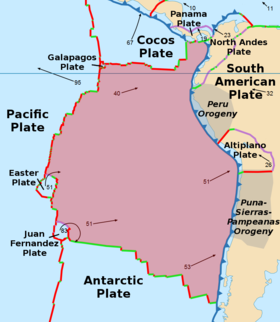| Nazca plate | |
|---|---|
 | |
| Type | Minor |
| Approximate area | 15,600,000 km2[1] |
| Movement1 | north-east |
| Speed1 | 40-53 mm/year |
| Features | Pacific Ocean |
| 1Relative to the African plate | |
The Nazca plate or Nasca plate,[2] named after the Nazca region of southern Peru, is an oceanic tectonic plate in the eastern Pacific Ocean basin off the west coast of South America. The ongoing subduction, along the Peru–Chile Trench, of the Nazca plate under the South American plate is largely responsible for the Andean orogeny. The Nazca plate is bounded on the west by the Pacific plate and to the south by the Antarctic plate through the East Pacific Rise and the Chile Rise, respectively. The movement of the Nazca plate over several hotspots has created some volcanic islands as well as east-west running seamount chains that subduct under South America. Nazca is a relatively young plate in terms of the age of its rocks and its existence as an independent plate, having been formed from the breakup of the Farallon plate about 23 million years ago. The oldest rocks of the plate are about 50 million years old.[3]
- ^ "Sizes of Tectonic or Lithospheric Plates". About.com Geology. Archived from the original on 9 February 2007. Retrieved 4 January 2016.
- ^ Oxford Atlas Of The World 26th Ed. New York, NY: Oxford University Press. 2019. p. 74. ISBN 978-0-19-006581-2.
- ^ Dutch, Steven (10 August 2009). "Sea Floor Spreading in the Pacific (Plate Boundaries Shown)". University of Wisconsin - Green Bay. Archived from the original on 17 March 2010.